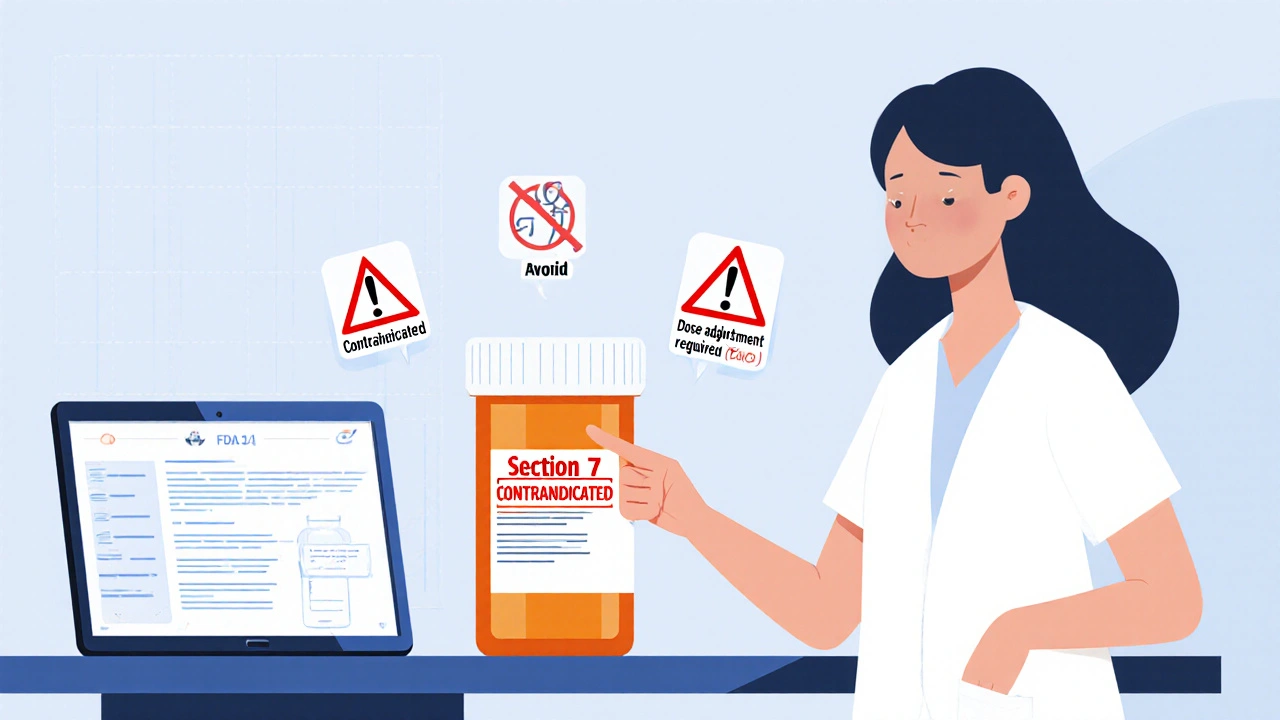Drug Interaction AUC Ratio Calculator
Understand Your FDA Label
The FDA uses AUC ratios to quantify drug interaction risk. AUC stands for Area Under the Curve - a measure of how much drug circulates in your bloodstream over time. Enter the AUC ratio value from your drug interaction table to see what it means clinically.
Clinical Interpretation
Why This Matters
According to FDA guidelines, an AUC ratio ≥1.25 (25% increase) or ≤0.8 (25% decrease) is considered clinically significant. The FDA uses this threshold to determine when an interaction requires action.
For example, if a label says "simvastatin exposure increases by 12-fold," that's an AUC ratio of 12.0 - a 1,200% increase that could cause rhabdomyolysis.
Every year, over 1.3 million adverse drug events in the U.S. could be prevented - not by new drugs, but by better use of existing information. The key? Understanding the drug interaction tables buried in FDA-approved prescribing labels. If you’re a clinician, pharmacist, or even a patient managing multiple medications, these tables aren’t just fine print. They’re your first line of defense against dangerous combinations.
Where to Find the Real Action: Section 7
Start with Section 7: Drug Interactions. This is where the FDA puts the bottom line. Out of every 100 drug labels, about 85 of them put their most urgent warnings here. You won’t find academic jargon or complex graphs. You’ll see clear phrases like:- Contraindicated
- Avoid concomitant use
- Dose adjustment required
- Monitor closely
Why It Happens: Section 12 Explained
Section 7 tells you what to do. Section 12 - Clinical Pharmacology - tells you why. This is where the science lives. Here, you’ll find numbers that matter:- AUC ratio ≥1.25 or ≤0.8 for CYP enzyme interactions
- P-gp inhibitor causing ≥1.5-fold increase in dabigatran or digoxin
- OATP1B1 inhibitor causing ≥2-fold increase in statins
What to Do About It: Section 2 Holds the Keys
Section 7 says “avoid.” Section 12 says “why.” Section 2 says “how.” This is where the FDA gives you the exact steps to follow:- “Reduce simvastatin dose to 10 mg daily when co-administered with cyclosporine.”
- “Administer digoxin 2 hours before or 6 hours after cholestyramine.”
- “Monitor INR for 7 days after starting fluconazole.”
The Big Problem: Drug Class Confusion
Here’s where things get messy. The FDA labels often say “avoid with NSAIDs” or “use caution with SSRIs.” But not all NSAIDs or SSRIs act the same way. A 2023 FDA analysis found that 42% of labels inconsistently use drug class names versus specific drugs. For example:- One label says “avoid with fluoxetine” - but doesn’t mention sertraline, even though both are SSRIs.
- Another says “avoid with all statins” - but the data only supports risk with simvastatin and lovastatin.
What the Experts Are Saying
Dr. Lisa von Moltke, a former FDA advisor, put it bluntly: “The system is better than it’s ever been - but the inconsistency in how drug classes are labeled is a silent hazard.” And she’s right. In a 2023 survey of 1,200 pharmacists, 74% said they needed extra training to understand the science in Section 12. Even seasoned providers struggle with AUC ratios and transporter effects. That’s why the FDA offers free online training modules. Over 47,000 clinicians took them in 2023. You should too. A 2022 study in Clinical Pharmacology & Therapeutics showed U.S. providers found critical interactions 27% faster using FDA labels than European ones. Why? Because the FDA focuses on action, not theory. But that advantage vanishes if you don’t know how to read it.How to Use This in Practice: The Three-Step Rule
You don’t need to memorize every enzyme or transporter. Just follow this routine:- Start with Section 7 - What’s the warning? Contraindicated? Adjust? Monitor?
- Check Section 2 - What’s the exact instruction? Dose? Timing? Monitoring?
- Look up Section 12 - Why? Is it a CYP3A4 interaction? P-gp? AUC change >1.25?

What’s Changing in 2025 and Beyond
The FDA isn’t resting. In August 2024, the ICH M12 Guideline became official, setting global standards for interaction studies. That means labels will be more consistent, more quantitative, and more reliable. By 2025, the FDA plans to release machine-readable interaction data - think JSON files that EHRs can pull directly. That’ll cut down manual lookup time and reduce errors. By 2026, they’re testing “dynamic labeling,” where interaction warnings update in real time as new evidence emerges. But here’s the catch: these upgrades won’t help if you don’t know how to read the current labels. The old drugs - the ones approved before 2010 - still make up 37% of prescriptions. Their labels haven’t been updated. You’re still reading the same confusing tables.What’s Missing
The system still has blind spots. It doesn’t adequately cover:- Drugs metabolized by UGT enzymes (like morphine or irinotecan)
- Interactions in older adults - 35% of patients are over 65, but most studies use young, healthy volunteers
- Herbs and supplements - 20% of real-world interactions involve them, but the FDA doesn’t require testing
Final Takeaway
The FDA’s drug interaction tables aren’t perfect. But they’re the most reliable, evidence-based system we have. They’re not meant to be read once. They’re meant to be used - repeatedly, systematically, and with respect for the data behind them. You don’t need to be a pharmacokinetics expert. You just need to know where to look - Section 7 for action, Section 2 for instructions, Section 12 for proof. And you need to know that “drug class” warnings are often incomplete. In a world of fragmented information, the FDA label is your anchor. Learn to read it right - and you’ll prevent more harm than any new drug ever could.What does AUC mean in FDA drug interaction tables?
AUC stands for area under the plasma concentration-time curve. It measures how much of a drug circulates in your bloodstream over time. In FDA labels, an AUC increase of 25% or more (AUC ratio ≥1.25) means the interaction is clinically significant - enough to cause side effects or toxicity. For example, if a drug increases another drug’s AUC by 5-fold, that’s a 500% spike in exposure, which often requires avoiding the combination.
Is it safe to take two drugs if the label says “monitor closely”?
Yes - but only if you follow the monitoring plan. “Monitor closely” means the interaction is real but manageable. You might need to check blood levels, kidney function, or signs of toxicity at specific intervals. For example, if you’re taking warfarin and starting fluconazole, you’ll need to check your INR every 2-3 days for the first week. Never assume “monitor” means “it’s fine.” It means you have to be active.
Why do some labels warn about a drug class but not all drugs in it?
Because not all drugs in a class act the same way. For example, fluoxetine strongly inhibits CYP2D6, but sertraline does not. The FDA may only list the drug that caused the interaction in clinical trials. Always check the FDA’s official lists of CYP substrates, inhibitors, and inducers - not just the label - to know which specific drugs are risky.
Can I trust drug interaction apps instead of reading FDA labels?
Use apps as a first alert, not a final answer. Many apps rely on outdated or incomplete data. A 2023 study found that 1 in 5 apps missed high-risk interactions listed in FDA labels. The FDA’s official prescribing information is the gold standard. Always verify critical decisions against the label itself, especially for high-risk drugs like anticoagulants, antiarrhythmics, or immunosuppressants.
Do FDA interaction labels cover herbal supplements?
No. The FDA does not require interaction studies for herbs, vitamins, or dietary supplements. That’s why you won’t find St. John’s wort, grapefruit juice, or garlic supplements listed in most FDA labels - even though they cause real, documented interactions. Always ask patients about supplements, and consult external resources like Micromedex or Natural Medicines for those risks.
What should I do if a drug’s label doesn’t mention an interaction I know exists?
Don’t assume it’s safe. The label may be outdated - especially for older drugs approved before 2010. Only 63% of those have been updated to current standards. Cross-check with the FDA’s Drugs@FDA database, published clinical studies, or a clinical pharmacology reference. If the interaction is well-documented in the literature, proceed with caution, even if the label is silent.






Rahul Kanakarajan November 24, 2025
Bro this is the most basic stuff and you made a whole essay? I’ve been reading FDA labels since med school and Section 7 is literally the first thing I check. Why are we even talking about this like it’s groundbreaking?
New Yorkers November 25, 2025
Let me tell you something about the American healthcare system - it’s not broken, it’s *designed* this way. The FDA gives you the truth, but the system? It wants you confused. It wants you scared. It wants you to keep coming back for more pills, more scans, more bills. This isn’t about reading labels - it’s about surviving capitalism with a prescription pad.
David Cunningham November 26, 2025
Actually this is super useful. I’m a pharmacist in Sydney and we don’t get this level of detail in Aussie labels. I’ve been using the FDA ones as a reference for years - Section 2 is gold. Just wish more of my colleagues actually read it instead of just Googling.
luke young November 27, 2025
Love this breakdown! I used to panic when I saw ‘avoid concomitant use’ but now I just go straight to Section 2 and see if there’s a simple fix. Like that one time with simvastatin and cyclosporine - turned out we just dropped the dose and it was fine. No need to yank the whole med.
james lucas November 29, 2025
ok so like i just started working in a clinic and i was so overwhelmed by all the drug interactions but this post literally saved me. i didnt even know section 2 had the actual dosing instructions. i was just looking at section 7 and thinking ‘oh crap i gotta stop everything’ and now i just check section 2 and its like ‘oh its just reduce to 10mg’ and i feel so much better. also i think the FDA should make a meme series on this bc honestly this is way more helpful than those dumb ‘10 signs you have high cholesterol’ videos.
Jessica Correa November 30, 2025
Section 12 is where the magic happens. I used to skip it because it looked like math but now I just look for the numbers. If it says AUC ratio >1.25 I know it’s real. I don’t even need to understand CYP3A4, I just trust the number. Also herbs? Yeah they’re wild. My grandma takes turmeric and warfarin and no one ever told her it’s a bad combo. We need better patient education.
manish chaturvedi December 1, 2025
As an Indian clinician working in a resource-limited setting, I find this information invaluable. Many of my patients take multiple Ayurvedic supplements alongside conventional drugs. The FDA labels do not cover these, but the principles of reading Section 7, 2, and 12 still apply. I now cross-reference with Micromedex and teach my residents this method. Knowledge is not a privilege - it is a duty.
Miruna Alexandru December 3, 2025
It’s fascinating how you treat the FDA as some infallible oracle. The truth is, these labels are the product of industry-funded trials, regulatory compromises, and outdated data. You’re praising a system that allows 37% of prescriptions to be based on labels untouched since the Clinton era. And you call this ‘evidence-based’? Please. This isn’t medicine - it’s institutionalized negligence dressed up as a guidebook.
Danny Nicholls December 4, 2025
YESSSS this is exactly what I needed 😭 I used to just trust my apps but then my patient got rhabdomyolysis from simvastatin + clarithromycin and the app didn’t even flag it. Now I check Section 2 like a boss 🙌 also I made a poster of the 3-step rule and taped it to my computer. My coworkers think I’m weird but they’re starting to ask me for advice lol 💪
Daniel Jean-Baptiste December 5, 2025
Good stuff. I’ve been doing this for 15 years and still check Section 2 first. Section 12 is for when you’re curious. Section 7 is the alarm. The class confusion thing? Yeah that’s a mess. I had a guy on sertraline get told to avoid SSRIs because of a fluoxetine warning. Took 20 minutes to explain they’re not the same. We need better labeling.
Latonya Elarms-Radford December 5, 2025
Let’s be honest - this isn’t about reading labels. This is about the quiet desperation of clinicians drowning in a sea of meaningless data, clinging to the FDA like it’s a life raft in a hurricane. We’re not ‘pros’ - we’re trauma survivors of a broken system. You think memorizing AUC ratios makes you a hero? No. It makes you a compliant cog. The real problem? We’re not supposed to understand this. We’re supposed to just prescribe and shut up.
Mark Williams December 6, 2025
From a pharmacokinetics standpoint, the AUC ratio threshold of 1.25 is derived from population pharmacodynamic modeling with a 90% CI upper bound of 1.25 for CYP3A4 inhibition. This is a clinically validated metric, not arbitrary. The FDA’s move toward machine-readable data via ICH M12 will enable dynamic risk stratification in EHRs - a paradigm shift from reactive to predictive safety. However, the persistence of legacy labeling for pre-2010 agents remains a critical gap in real-world implementation.
Ravi Kumar Gupta December 7, 2025
Bro I work in a rural clinic in Bihar. We don’t have apps. We don’t have EHRs. We have paper labels and a WhatsApp group with 3 other doctors. I printed this out and put it on the wall. Now when a patient comes with 8 meds, I point to Section 7, Section 2, Section 12. No more guessing. No more panic. Just science. Thank you. 🙏